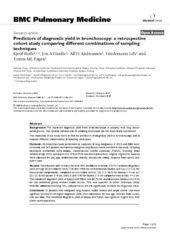| dc.contributor.author | Roth, Kjetil | en_US |
| dc.contributor.author | Hardie, Jon Andrew | en_US |
| dc.contributor.author | Andreassen, Alf H. | en_US |
| dc.contributor.author | Leh, Friedemann | en_US |
| dc.contributor.author | Eagan, Tomas Mikal | en_US |
| dc.date.accessioned | 2011-11-28T09:40:05Z | |
| dc.date.available | 2011-11-28T09:40:05Z | |
| dc.date.issued | 2008-01-26 | eng |
| dc.Published | BMC Pulmonary Medicine 8(2) | en |
| dc.identifier.issn | 1471-2466 | |
| dc.identifier.uri | https://hdl.handle.net/1956/5232 | |
| dc.description.abstract | Background: The reported diagnostic yield from bronchoscopies in patients with lung cancer varies greatly. The optimal combination of sampling techniques has not been finally established. The objectives of this study were to find the predictors of diagnostic yield in bronchoscopy and to evaluate different combinations of sampling techniques. Methods: All bronchoscopies performed on suspicion of lung malignancy in 2003 and 2004 were reviewed, and 363 patients with proven malignant lung disease were included in the study. Sampling techniques performed were biopsy, transbronchial needle aspiration (TBNA), brushing, small volume lavage (SVL), and aspiration of fluid from the entire procedure. Logistic regression analyses were adjusted for sex, age, endobronchial visibility, localization (lobe), distance from carina, and tumor size. Results: The adjusted odds ratios (OR) with 95% confidence intervals (CI) for a positive diagnostic yield through all procedures were 17.0 (8.5–34.0) for endobronchial lesions, and 2.6 (1.3–5.2) for constriction/compression, compared to non-visible lesions; 3.8 (1.3–10.7) for lesions > 4 cm, 6.7 (2.1–21.8) for lesions 3–4 cm, and 2.5 (0.8–7.9) for lesions 2–3 cm compared with lesions <= 2 cm. The combined diagnostic yield of biopsy and TBNA was 83.7% for endobronchial lesions and 54.2% for the combined group without visible lesions. This was superior to either technique alone, whereas additional brushing, SVL, and aspiration did not significantly increase the diagnostic yield. Conclusion: In patients with malignant lung disease, visible lesions and larger tumor size were significant predictors of higher diagnostic yield, after adjustment for sex, age, distance from carina, side and lobe. The combined diagnostic yield of biopsy and TBNA was significant higher than with either technique alone. | en_US |
| dc.language.iso | eng | eng |
| dc.publisher | BioMed Central | eng |
| dc.relation.ispartof | <a href="http://hdl.handle.net/1956/5234" target="blank">Bronchoscopy of lesions suspicious of malignancy: Predictors of a higher diagnostic yield, the optimal combination of sampling techniques, and evaluation of endobronchial ultrasound with a rotating miniprobe. A retrospective cohort study and a prospective open randomised real-life study among physicians with various levels of experience</a> | eng |
| dc.rights | Attribution CC BY | eng |
| dc.rights.uri | http://creativecommons.org/licenses/by/2.0/ | eng |
| dc.title | Predictors of diagnostic yield in bronchoscopy: a retrospective cohort study comparing different combinations of sampling techniques | en_US |
| dc.type | Peer reviewed | |
| dc.type | Journal article | |
| dc.description.version | publishedVersion | en_US |
| dc.rights.holder | © 2008 Roth et al; licensee BioMed Central Ltd | |
| dc.identifier.doi | https://doi.org/10.1186/1471-2466-8-2 | |
| dc.subject.nsi | VDP::Medical disciplines: 700::Clinical medical disciplines: 750::Oncology: 762 | eng |
| dc.subject.nsi | VDP::Medical disciplines: 700::Clinical medical disciplines: 750::Lung diseases: 777 | eng |

